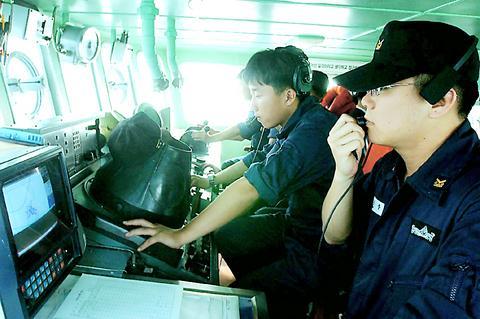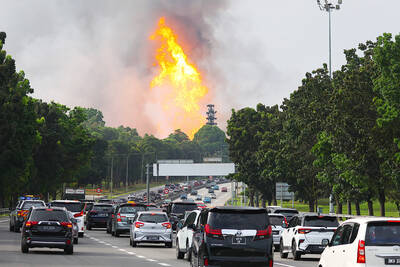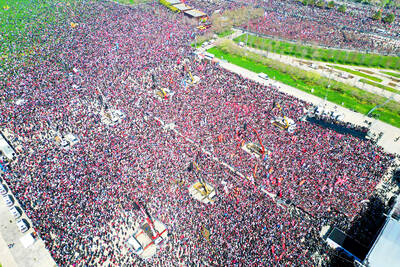The South and North Korean navies established radio contact for the first time yesterday in a major step towards easing tension on the Cold War's last frontier, officials said.
Warships from the two sides successfully communicated using a common radio frequency, flags and light signals along a disputed sea border in the Yellow Sea as part of new measures to prevent accidental clashes, navy officials said.

PHOTO: AP
"Navy ships from both sides have been in radio contact from 00:00 GMT, sailing along the sea border off the west coast," a South Korean navy spokesman said.
The first exchange of radio messages was made near Yeonpyeong Island when navy ships from both sides sailed close to the sea border. Similar contacts were made at four other locations for two hours.
The unprecedented contact comes a day before the two Koreas hold a series of joint events to mark the signing of a landmark rapprochement agreement at a summit between them in 2000.
A North Korean civilian delegation arrived in South Korea yesterday to attend a marathon and other reconciliation events. Pyongyang will also send a government delegation to Seoul this week for a symposium on a railway project linking the peninsula with Europe.
The 2000 summit prompted a thaw between the North and South but ties have been disrupted by naval skirmishes in the rich fishing grounds off the western coast.
Since 1999 dozens of casualties have been reported on both sides. The last clash in June 2002 left six South Korean sailors dead.
Clashes usually occur when fishing boats from one side cross an unmarked maritime border into the other side while chasing fish.
A temporary sea border, called the Northern Limit Line, was drawn in 1953 at the end of the three-year Korean War, but North Korea has never recognized it, insisting the sea border should be redrawn.
Yesterday's contact followed a military deal on June 4 to reduce tensions along the heavily fortified and tense border.
In terms of the accord, the two sides are from midnight Monday to stop propaganda broadcasts along the 248km land border.
They have also agreed to dismantle all propaganda materials aimed at enticing opposing soldiers to defect.
South Korea has about 100 propaganda billboards along the land border. North Korea has erected 200 huge signs and drawings praising their leader and communism or denouncing the US.
The border is dotted with loudspeakers, slogans, electronic displays, posters and religious facilities.
The rapprochement comes at a sensitive time, with an international diplomatic drive under way to encourage the Stalinist North to abandon its nuclear ambitions.
North Korea has a 1.1 million-strong force against South Korea's 690,000 troops, who are backed by 37,000 US soldiers.
The US, however, plans to reduce its troop levels on the peninsula and move US forces away from the border to locations south of Seoul. The plans have triggered security jitters in South Korea.

A fire caused by a burst gas pipe yesterday spread to several homes and sent a fireball soaring into the sky outside Malaysia’s largest city, injuring more than 100 people. The towering inferno near a gas station in Putra Heights outside Kuala Lumpur was visible for kilometers and lasted for several hours. It happened during a public holiday as Muslims, who are the majority in Malaysia, celebrate the second day of Eid al-Fitr. National oil company Petronas said the fire started at one of its gas pipelines at 8:10am and the affected pipeline was later isolated. Disaster management officials said shutting the

US Vice President J.D. Vance on Friday accused Denmark of not having done enough to protect Greenland, when he visited the strategically placed and resource-rich Danish territory coveted by US President Donald Trump. Vance made his comment during a trip to the Pituffik Space Base in northwestern Greenland, a visit viewed by Copenhagen and Nuuk as a provocation. “Our message to Denmark is very simple: You have not done a good job by the people of Greenland,” Vance told a news conference. “You have under-invested in the people of Greenland, and you have under-invested in the security architecture of this

Japan unveiled a plan on Thursday to evacuate around 120,000 residents and tourists from its southern islets near Taiwan within six days in the event of an “emergency”. The plan was put together as “the security situation surrounding our nation grows severe” and with an “emergency” in mind, the government’s crisis management office said. Exactly what that emergency might be was left unspecified in the plan but it envisages the evacuation of around 120,000 people in five Japanese islets close to Taiwan. China claims Taiwan as part of its territory and has stepped up military pressure in recent years, including

UNREST: The authorities in Turkey arrested 13 Turkish journalists in five days, deported a BBC correspondent and on Thursday arrested a reporter from Sweden Waving flags and chanting slogans, many hundreds of thousands of anti-government demonstrators on Saturday rallied in Istanbul, Turkey, in defence of democracy after the arrest of Istanbul Mayor Ekrem Imamoglu which sparked Turkey’s worst street unrest in more than a decade. Under a cloudless blue sky, vast crowds gathered in Maltepe on the Asian side of Turkey’s biggest city on the eve of the Eid al-Fitr celebration which started yesterday, marking the end of Ramadan. Ozgur Ozel, chairman of the main opposition Republican People’s Party (CHP), which organized the rally, said there were 2.2 million people in the crowd, but